Special feature: Tracing international exchange through archaeological sites
Largest trading port in the archipelago, serving as bridge to Asia
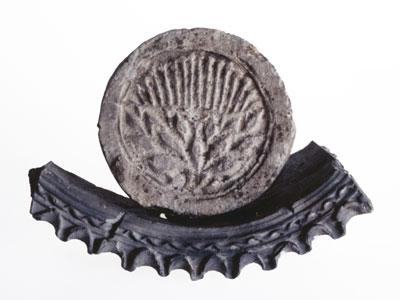
Chinese style roof tiles Bearing designs not known in Japan, round eave tiles with a floral pattern impressed from a mold, or flat eave tiles with frilled lower edges, are thought to have been imported from China or produced in the vicinity of Hakata by Chinese artisans. |
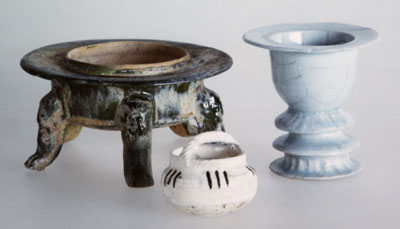
Glazed wares The item in front is a dragon-shaped vessel of white porcelain with iron brushwork, to the left is a green glazed censer, and to the right is a celadon lantern. |
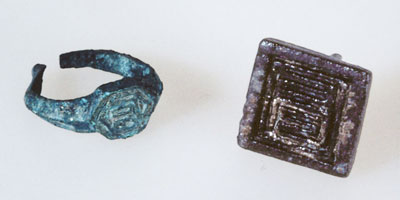
Phagspa script seals Seals have been found inscribed in the Phagspa script, an alphabet devised at the orders of Yuan emperor Kublai Kan. Perhaps Mongol merchants visited the port. |
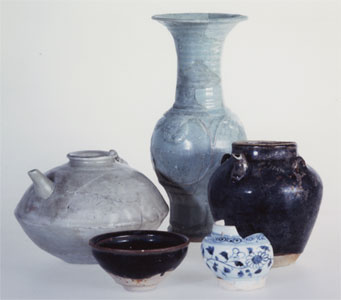
Glazed wares From front left are a lustrous black-iron glazed bowl popular among Kamakura samurai, and a Yuan blue and white vase. From the left in back are a porcelain pitcher, celadon flower vase, and black glazed pitcher. |
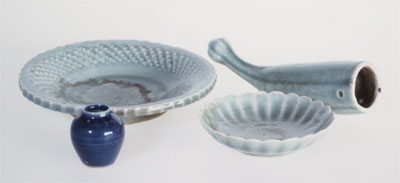
Glazed wares From front left are a cobalt glazed small vase, a Jingdezhen porcelain saucer; from back left are a Longquan Yao celadon plate, and a Jingdezhen porcelain flower vase. |
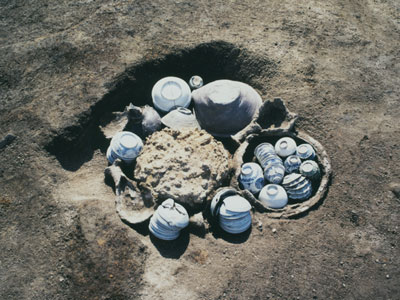
Cache of glazed wares Chinese and Korean glazed pottery buried together in a cache. Were they buried for protection from the conflagrations of Japan’s Warring States period (latter half of the sixteenth century)? Bizen ware grinding bowls, iron pots, and tin sake bottles were also buried. |
Hakata Site Group, Fukuoka City, Fukuoka Prefecture
The group of sites at Hakata are from the medieval city which served as an international port under that name. The sites sleep buried beneath the modern city center, from Hakata station towards the port of Hakata. Sites built on top of sand dunes facing Hakata bay flourished from the latter half of the eleventh up to the end of the sixteenth centuries as Japan’s largest trading port.
An abundance of imported glazed wares
A wide variety of imported glazed wares have been recovered in abundance from the group of sites at Hakata, testifying to its prosperity as a trading port. In addition to the glazed wares that were conveyed via Hakata throughout the rest of Japan, there are also unusual types not known from other sites.
Especially in the twelfth century, there was a Chinese district within Hakata known as Tōbō. The high incidence of Chinese surnames written in ink on glazed wares recovered from the sites at Hakata bear this out. Chinese merchants living in Tōbō brought a variety of goods with them besides glazed wares, such as glass vessels and hooped wooden buckets, which they used in their daily lives.
A city open to Asia
In the Muromachi period Hakata served as the base for sending and receiving tribute ships in exchanges with the Chinese Ming dynasty, and in trade with Korea and the Ryūkyūs, in which Hakata merchants played a significant part. Goods from Southeast Asia were also unloaded, brought via the Ryūkyūs.
In the first half of the sixteenth century the Iwami silver mine was discovered; it was developed by a Hakata merchant, Kamiya Jutei, using techniques brought from Korea. Thus Hakata also served as locus for receiving advanced technology from overseas.
At the beginning of the Edo period, under the closed door policy of the Tokugawa bakufu, Hakata lost its function as a port for conducting overseas trade. In this manner, the curtain fell upon Hakata as the largest trading port in Japan for a span of nearly five hundred years, beginning in the Heian period. (Ōba Kōji)
